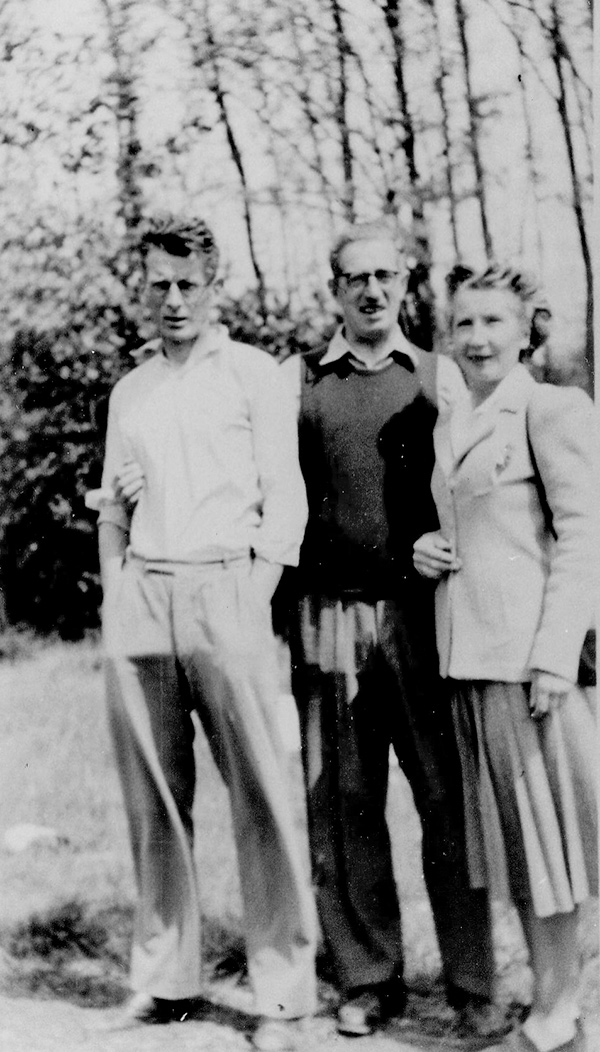Letters from an Elusive Playwright
New volume of Samuel Beckett's correspondence illuminates work, life

The artist as a young man: Samuel Beckett (left to right) in Ussy-sur-Marne commune in France, with his brother, Frank, and his lover and later wife, Suzanne Dechevaux-Dumesnil.
Courtesy The Estate of Samuel Beckett
Samuel Beckett—the Irish avant- garde novelist, theater director, and playwright—once wrote that “every word is like an unnecessary stain on silence and nothingness.”
His more than fifteen thousand letters, spanning six decades of the twentieth century, tell a different story. They reveal a softer side of the self-effacing, reticent writer who refused to attend his own Nobel Prize ceremony and preferred to let the words on the page speak for themselves.
Published last fall, The Letters of Samuel Beckett, 1941―1956 (Cambridge University Press, 2011) is the much-anticipated second volume from a team of editors at Emory, the University of Sussex, and the American University of Paris, assisted during the course of twenty-five years by a progression of more than one hundred Emory undergraduate and graduate students.
In October, Emory’s Laney Graduate School celebrated the volume’s release with “Words Are All We Have: From ‘Watt’ to ‘Godot’, ” featuring readings by noted Irish actor Barry McGovern and Atlanta actors Carolyn Cook, Robert Shaw-Smith, and Brenda Bynum, who is a former resident artist and lecturer with Theater Emory.
In 1985, Beckett authorized founding editors Martha Dow Fehsenfeld and Emory’s Lois More Overbeck to edit a selected edition of his letters. Fehsenfeld had observed Beckett directing several of his plays, including Krapp’s Last Tape and Endgame, in preparation for her 1988 book, Beckett in the Theatre, written with Dougald McMillan.
The Beckett Letters Project became affiliated with Emory’s Laney Graduate School in 1990 and has since received four grants from the National Endowment for the Humanities, along with support from the Florence Gould Foundation and other research grants.
The first volume of The Letters of Samuel Beckett, 1929―1940, published in 2009, won international acclaim. It revealed a passionate and vulnerable young Beckett, immensely irritated by his own writing and the achingly slow pace of success.
The second volume primarily focuses on Beckett’s post―World War II years, after he joined the French Resistance and was forced into hiding. It chronicles the beginning of Beckett’s mature and most celebrated work written in French, including Molloy, Malone Meurt, L’Innomable, and En Attendant Godot.
Beckett was nearly fifty years old when Waiting for Godot brought him public success, yet his relationship to the play—as with much of his other work—was a combination of “attachment” and “revulsion,” the book editors write. As Beckett wrote to his lover Pamela Mitchell in 1953 following the play’s premiere, “I went to Godot last night for the first time in a long time. Well played, but how I dislike that play now. Full house every night, it’s a disease.”
Volumes three and four are expected to be published by 2015, along with a general-interest volume that will include elements of all four. “Each of the volumes is like a kaleidoscope,” says Overbeck, Emory project director and a research associate in the Laney Graduate School. “You give it a quarter turn and another picture emerges.”
In the early 1990s, building on a sparse collection of drafts donated by the writer himself, the researchers involved in the Beckett Letters Project launched an ambitious effort to hunt through archives and private collections. Their meticulous legwork involved accounting for each and every book, painting, and piece of music mentioned in Beckett’s correspondence.
They contacted the French national meteorological service to verify historical weather patterns, consulted with Emory Eye Center doctors about Beckett’s cataracts, and called every Desmond Smith in the Toronto telephone directory to locate the one who had written to Beckett in 1956 with questions about Waiting for Godot.
Beckett’s letters were often undated and written in horrendous script due to his crippled, arthritic fingers and, at times, poor eyesight. Letters were often passed among the volume’s editors—Fehsenfeld; Overbeck; George Craig, honorary research fellow at the University of Sussex; and American University in Paris professor Dan Gunn—littered with question marks.
“We’re very pleased when we actually get one that’s typed, though he would wear out the typewriter tape until there was nothing left,” says editorial assistant Melissa Holm.
“Over time, this work will result in a much deeper grasp of Samuel Beckett as a thinker and artist as he came to understand himself in conversation with a wider literary and scholarly community,” says Vice President and Secretary of the University Rosemary Magee.





